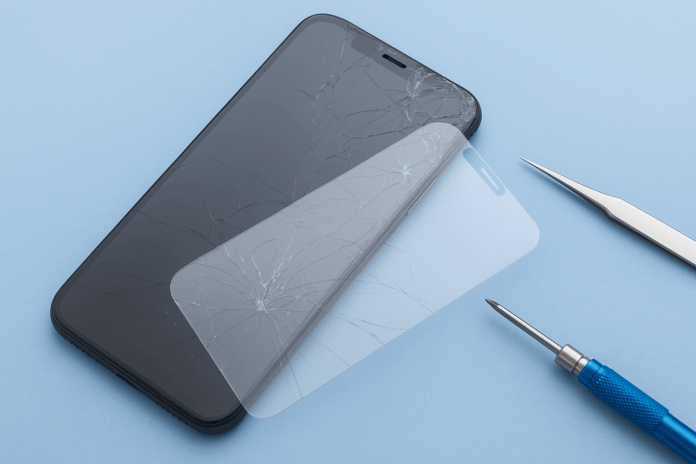Modern smartphones pack complex display systems combining multiple technological layers. These screens integrate capacitive touch sensors, anti-fingerprint coatings, and sophisticated pixel architectures. Understanding how OLED, AMOLED, and LCD panels work helps you protect them better and recognize when professional repair becomes necessary.
Display technology has evolved beyond simple glass and pixels. Tech-savvy users benefit from knowing these technical aspects, leading to informed protection decisions and helping identify repair needs before minor issues become complete failures.
Table of contents
Display Technology Fundamentals: OLED vs LCD Architecture
Before diving into protection methods, you need to understand what you’re actually protecting. Different display technologies have different weak points, and knowing these differences shapes your protection strategy.
LCD Technology and Layer Structure
LCDs use a layered architecture starting with LED backlights at the bottom. The TFT (Thin-Film Transistor) matrix controls individual pixels through liquid crystal molecules that twist to block or allow light passage. Color filters create red, green, and blue subpixels.
The touch digitizer integrates as a separate layer between protective glass and the LCD panel. This capacitive sensor grid detects capacitance changes at specific coordinates when you press the screen. The controller IC processes these signals and sends touch data to your phone’s processor.
LCD architecture creates specific vulnerability points. The backlight diffuser cracks under pressure, causing bright spots. The liquid crystal layer fails when exposed to extreme temperatures below -10°C (-14°F) or above 60°C (140°F). The digitizer’s copper traces break from repeated flexing at drop impact points.

OLED/AMOLED Technology Advantages
OLED panels eliminate backlights through self-emissive technology. Each pixel contains organic compounds that emit light when an electric current passes through them. Samsung’s AMOLED adds a TFT layer for better pixel addressing.
The backplane technology determines performance. LTPS (Low-Temperature Polysilicon) backplanes offer high electron mobility, enabling faster refresh rates. LTPO (Low-Temperature Polycrystalline Oxide) technology dynamically adjusts refresh rates from 1Hz to 120Hz, saving battery power during static content display.
OLED screens crack differently from LCD panels because they lack rigid backlight structures. The thin film encapsulation protecting organic materials from moisture becomes the primary failure point. Once this barrier breaks, moisture triggers rapid pixel degradation, appearing as dark spots spreading across your screen.
Technical Protection Methods for Modern Displays
Now that you understand the architecture, let’s look at protection methods that actually work at the technical level. Each approach targets specific vulnerability points in your display’s construction.
Advanced Screen Protector Technology
Tempered glass protectors undergo ion exchange at 400°C (752°F). Manufacturers immerse aluminosilicate glass in molten potassium salt baths. Smaller sodium ions swap with larger potassium ions, creating compressive stress, achieving 9H hardness on the Mohs scale.
The 9H rating means the glass resists scratching from materials softer than it. Keys (brass at 3-4H) and coins cannot scratch it. However, sand particles containing quartz (7H) still cause damage. The rating indicates surface hardness, not impact resistance.
Oleophobic nano-coatings reduce fingerprints through molecular-level surface modification. Manufacturers apply fluoropolymer compounds in 10-100 nanometre thickness. Plasma coating processes bond these compounds permanently, lasting 6-12 months versus 2-3 months for spray methods.
UV-cured liquid screen protectors fill microscopic surface irregularities with liquid glass compounds. UV light triggers polymerization, hardening the coating. These add 1-2H surface hardness but lack the impact absorption of tempered glass.
Display-Specific Protection Strategies
OLED burn-in occurs when static elements are displayed for extended periods. Modern OLED panels use pixel shift technology, moving content by 1-2 pixels periodically. Enhance this by enabling auto-brightness and setting the screen timeout to 30 seconds or less.
LCD backlight bleed appears as bright spots from pressure damage. Cases should maintain at least 0.5mm (0.02 inches) clearance between the phone’s back and surfaces when laid flat.
Touch sensitivity suffers when screen protectors add dielectric material between your finger and the capacitive sensor. Enable touch sensitivity boost in settings when using tempered glass protectors. This increases digitizer voltage, compensating for added distance.
Technical Indicators Requiring Professional Display Repair
Even with proper protection, displays eventually fail. Recognizing these technical symptoms early saves you from more expensive problems down the line.
Digitizer Layer Failure
The capacitive touch sensor uses a grid of transparent ITO (Indium Tin Oxide) traces in rows and columns. Damage to these traces creates dead zones where touch detection fails.
Ghost touch happens when electrical interference affects the digitizer controller. Damaged flex cables create floating ground connections, causing phantom touch events. This often worsens when charging, as power supply noise couples into the damaged digitizer circuit.
Multi-touch failure indicates controller IC problems. When gestures like pinch-to-zoom stop working, the controller has failed or its connection to the logic board has broken.
Display Panel Degradation
LCD damage manifests as backlight problems or liquid crystal failure. Backlight diffuser damage creates bright spots. Polarizer separation appears as rainbow patterns from heat exposure above 60°C (140°F).
OLED pixel degradation follows organic compound breakdown. Blue subpixels degrade fastest, causing color shift toward yellow-red. Green tint issues stem from manufacturing variations becoming more visible as panels age.
Flex cable damage disconnects display components from the logic board. You notice this as intermittent display problems, screen flickering, or complete blackouts that temporarily fix when pressing the screen edges.
Advanced Diagnostic Signs
Dead pixels result from complete transistor failure, remaining black regardless of content. Stuck pixels show constant color when transistors lock in the “on” position. Dead pixels require panel replacement.
Screen retention differs from burn-in through its temporary nature. Retention fades within minutes after displaying varied content. Permanent ghosts after several hours confirm burn-in.
Professional Repair Technology and Methods
When your display fails, the repair quality depends entirely on the technology and expertise available. Here’s what separates professional repairs from quick fixes.
Display Replacement Technology
OEM display assemblies include manufacturer-matched components with identical specifications. Aftermarket displays use compatible but not identical components, showing differences in maximum brightness (often 100-150 nits lower) and color accuracy.
In-cell technology integrates touch sensors directly into the display stack during manufacturing. Oncell displays touch sensors on top of the panel. In-cell screens offer better touch sensitivity and thinner profiles.
Screen calibration becomes necessary after display replacement. Professional repair services use calibration equipment to program color profiles, brightness curves, and touch sensitivity maps. Without calibration, you get incorrect colors and touch accuracy issues.
Advanced Repair Techniques
Micro-soldering repairs damaged flex cables using microscopes and precision equipment to work with 0.4mm (0.016 inches) components. This repairs display connector damage without replacing the entire logic board.
OLED panel separation uses controlled heat or laser systems to soften the adhesive. Heat methods risk damage if the temperature exceeds 80°C (176°F). Laser separation provides precise control.
Frame alignment affects display function significantly. Even 0.2mm (0.008 inches) misalignment causes uneven pressure distribution. Professional repairs use alignment jigs, ensuring proper mounting.
Finding a reliable phone screen repair store in Melbourne, Victoria, with advanced equipment makes all the difference. FixUPP Phone Repair locations stock OEM-quality displays and maintain calibration tools for proper configuration, ensuring your repaired display performs exactly like the original.

When Display Repair Makes Technical Sense
Compare display assembly costs against the current market value. For phones under two years old, repair costs typically run 25-35% of replacement cost. A $350 (AUD) display replacement makes sense for phones worth $1200 (AUD) or more.
Modern processors remain capable for 4-5 years. Batteries degrade faster, losing 20% capacity after 500 charge cycles. If your phone needs both battery and display replacement, combine these repairs.
Quality iPhone screen repair service through certified providers maintains device integrity and True Tone functionality. For Melbourne users, finding repair services meeting these technical standards protects your investment while extending device lifespan.
Conclusion
Understanding display technology transforms how you protect and maintain your smartphone. OLED and LCD architectures each have specific vulnerabilities that technical knowledge helps you avoid. Technical knowledge helps identify repair needs at early stages, preventing unnecessary repairs and ensuring technicians address root causes. Professional repair preserves display calibration and system integration, maintaining your phone’s full functionality and extending its operational life by years.











